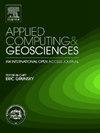GPU-accelerated simulation of steady-state flow and particle transport in discrete fracture networks
IF 3.2
Q2 COMPUTER SCIENCE, INTERDISCIPLINARY APPLICATIONS
引用次数: 0
Abstract
Fracture networks in the subsurface can serve as the primary pathway for fluid flow, allowing for solute transport. This process is critical to various real-world applications, including resource extraction and contaminant migration in fractured rocks. We develop an open-source code called cuDFNsys to simulate flow and transport in discrete fracture networks (DFNs). Our code uses the mixed hybrid finite element method to solve the hydraulic head and velocity fields in DFNs, and the particle tracking method to simulate the movement of solute plumes. The GPU parallelization accelerates the generation of DFNs, identification of intersections between fractures, determination of elementary matrices, and motion of particles. We use several benchmarks to verify the accuracy of flow and transport simulation in cuDFNsys. Dispersion in a DFN is used to demonstrate examples of particle tracking. Performance analyses demonstrate that our code is well-suited for Monte Carlo iterations of DFN simulations, enabling physicists and geoscientists to study critical phenomena and phase transitions in fracture networks using percolation theory.
离散断裂网络中稳态流动和粒子输运的gpu加速模拟
地下裂缝网络可以作为流体流动的主要通道,允许溶质运输。该过程对于各种实际应用至关重要,包括资源提取和裂缝岩石中的污染物运移。我们开发了一个名为cuDFNsys的开源代码来模拟离散裂缝网络(DFNs)中的流动和传输。我们的代码采用混合混合有限元法求解DFNs中的水头和速度场,采用粒子跟踪法模拟溶质羽流的运动。GPU的并行化加速了dfn的生成、裂缝间交点的识别、初等矩阵的确定和粒子的运动。我们使用几个基准来验证cuDFNsys中流量和传输模拟的准确性。DFN中的色散被用来演示粒子跟踪的例子。性能分析表明,我们的代码非常适合DFN模拟的蒙特卡罗迭代,使物理学家和地球科学家能够使用渗透理论研究裂缝网络中的关键现象和相变。
本文章由计算机程序翻译,如有差异,请以英文原文为准。
求助全文
约1分钟内获得全文
求助全文
来源期刊

Applied Computing and Geosciences
Computer Science-General Computer Science
CiteScore
5.50
自引率
0.00%
发文量
23
审稿时长
5 weeks
 求助内容:
求助内容: 应助结果提醒方式:
应助结果提醒方式:


